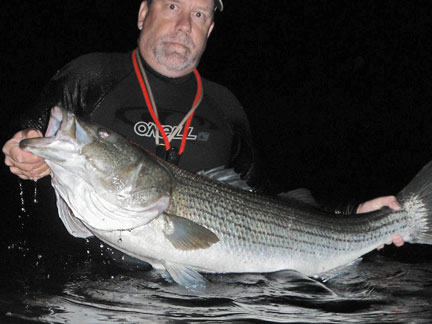
Perhaps the issue needs to be re-visited for a push to make the striped bass a gamefish coast-wide...
By DJ Muller
Is there a problem with the state of the striper stock? If there
is, how is it affecting our surfcasting? What does the future
hold? All these questions seem to have surfaced over the last few
months, a lot of it having to do with a sub-par fall run which
disappointed the majority of the striper hunting koo-koo birds,
myself included. This coming after a year in which there was no
fishing, thank you Sandy, and that coming after quite possibly the
best run ever, especially along New Jersey's beaches. It seems to
have gone from riches to rags. Personally, I did my due diligence
last year as I always do but not with the fervor of my normal
agenda, again largely due to the amount of construction or should
I say reconstruction (again thank you Sandy) along the Jersey
Shore. My experiences garnered pretty much the same fishing in
regards to numbers as in past years but a notable drop-off in
size, by that I mean fish over 30 pounds.
 |
| New Jersey striped bass anglers have an opportunity to help ensure a healthy population of the linesiders for a new generation of anglers. |
1996 was a huge spawning class for striped bass, or as it is called "Young of the Year Index," and the commonly referenced index is the Chesapeake Bay and its tributaries. The YOY Index is determined by scientist doing a series of seines during the year and the average amount of striped bass netted gives you the year's YOY index. The seines are done at 22 locations in the Chesapeake Bay and its tributaries, three times a year (in June, July and August), two seines per day, 30 minutes apart, that equals 132 actual seines so as you can see it is a pretty thorough sampling. Now back to the '96 year class, these stripers hit their optimum size (30 pound+) after about 14 years, these fish averaging 32.0 pounds on up. So 1996 plus 14 years brings us to 2010. By 2014 these fish are at mama-jama size averaging between 50-55 pounds, that would make the '96 class the one that we have collectively been pounding relentlessly for the last seven years. I honestly don't think that the class has held up to the amazing amount of pressure and the big fish have disappeared. This would explain the absence of big bass.
Let me back up a little and talk to you about the pressure we have put on the '96 fish. We Jersey guys pounded these fish on our beaches and jetties with the spring bunker blitzes from 2005 until 2 years ago. We killed thousands of fish from 25 pounds right on up through 50 pounds without discretion. Then the fish would migrate north to Montauk and the rips between Montauk and up and around Block Island where again they would get pounded by the party and charter boats for most of the year, think about it, 20- 30 boats a day, all taking their limits, multiple trips, mostly big fish, BA-BOOM! Now let's go a little further north, to the Cape Cod Canal where big bass push hordes of bait through the canal on a gut-stuff of mammoth proportions. While this happens both sides of the canal have guys casting hundreds of lures to fish that are on a major gut-stuff and many, many fish get taken, few are returned to the water. The number of fish that walk off the canal daily gets scary. I heard from one guy that rode his bike from one end of the canal to the other end after a solid push of fish, he counted over 400 dead fish lying on the rocks and path. That's one side, one tide, one morning. If you aren't sick to your stomach yet, there's Monomoy, where a friend said the fish again get pounded all summer, a lot of commercial activity, he also said that he has watched as guys didn't even hook and fight the fish, they stood and just gaffed fish and threw them into the boat as they fed on the surface. What the hell?!!! Oh and I haven't mentioned the North Carolina charter fleet that again pounds these fish while they stage in the winter. These fish never get a reprieve, everywhere they go they are targeted. But why do they all have to be killed?? Why can't they be enjoyed and then be released to be caught again?
 |
| Practicing "Catch and Release" helps secure a lower mortality rate, keeps large breeder females in the population and allows others to catch trophy bass as well. |
Why do fish like these have to be killed?
Perhaps the issue needs to be re-visited about making a push to
make the striped bass a gamefish coast-wide. Perhaps a campaign is
in order.
Fair is Fair...
1996 was a great year for spawning, the best ever and we were
rewarded with good fishing some 10-15 years later. 2001 was also a
good production year, the second best recorded, add 15 years and
2016, or these next couple years, should be productive.
As I fished last season, the majority of my fish went between 15-
25 pounds, lots of teenagers, probably from the '03-'06 year
class, which were very moderate years, not terrible, not great
years, the bigger fish, 20 pound class, were probably from the
2003 class (a solid year). The cows were few and far between. But
on the other hand I must have caught 200-300 fish less than 25
inches, almost two years old, probably from the good '11 year.
What does this mean to me? A large majority of the '93 and '96
year classes have been killed off. Of course there will still be
some large remaining, possibly enough for those of us that fish
hard to keep our hopes up and be rewarded for our efforts. Now the
small fish and their sheer numbers, points to a good future. Those
small fish are the result of a good 2011 spawn, we will watch them
grow and upsize for the next 10 years where they will then become
a fun size again, they will become giants by 2026…if we are good
stewards of what we have.
The bottom line is we have to think about fish for tomorrow. We have to do all we can do to be sure that there is a striper future in the surf. You can do that by catching and releasing your fish, especially large as they are...the big breeders (30 pound class will average 3.5 million eggs per spawn). I feel that the stock is in decent shape and the future looks promising, but that doesn't mean we have a cake walk here. There is a hell of a lot more people fishing today than there was even 10 years ago and there is a lot more fishing pressure on stripers. That is due to the internet and instant up to the second reporting, it is also due to much better technology with fish finders in boats that can find bodies of fish so much quicker than the old days, and equipment now that supersedes anything previous. If the fish are going to get a chance it is going to be the chance we personally give them. I have kept roughly 6 fish over the last 4 years. We will not get any help from the powers that be, trust me. They will only act if there is disaster, they are reactive, not proactive. It sits on us as anglers. It is our responsibility to catch and release and to treat our bass with respect, quick and careful releases, catch-photograph, (weigh), and release (yes CPR). In doing so, we will let our future swim for another day...and we will experience good fishing for the years to come!















